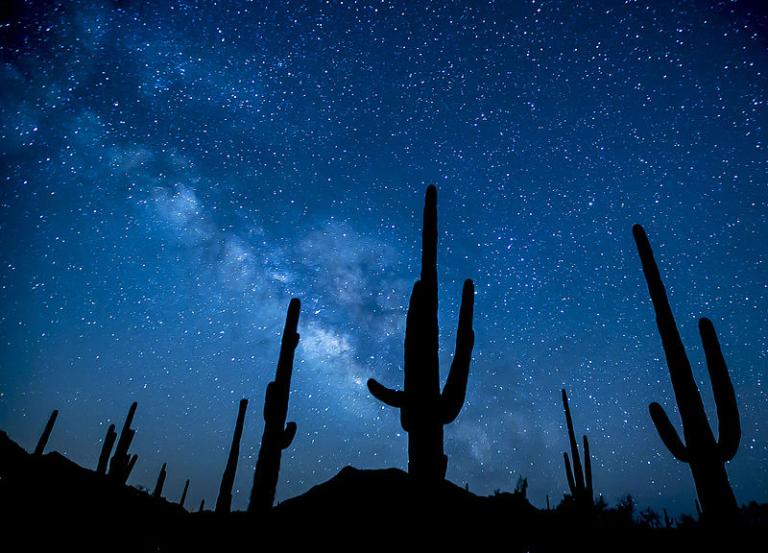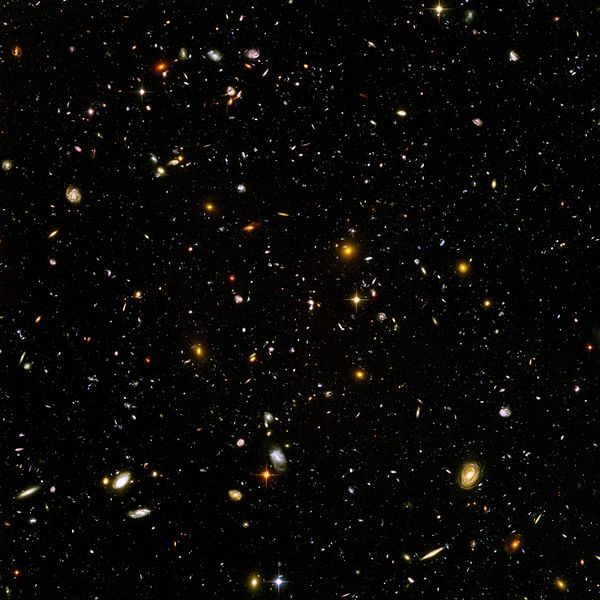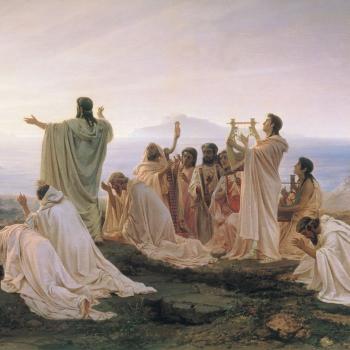
The Sabbath seems — especially during a period when we’re not getting out much — an unusually appropriate day on which to marvel at how very big and grand it all is. So I borrow here a couple of passages from David Wilkinson, God, Time and Stephen Hawking: An Exploration into Origins (London and Grand Rapids: Monarch Books, 2001):
Using these units [light years, each one of them “the distance travelled by light, at its constant speed of approximately 300,000,000 metres per second, over the time of one year”] the distance to the nearest star, Proxima Centauri, is about four light years.
Proxima Centauri and our Sun are among the stars that make up the Milky Way galaxy. This group of stars is visible on a clear night, if you can get away from street lighting, as a diffuse band of light across the sky. It contains 100 billion stars grouped together in a spiral pattern in a thin disc.
We are located about two-thirds of the distance away from the centre in the disc. At the centre there is a huge black hole the size of 2.5 million suns. The total diameter of the Milky Way is 100,000 light years. By multiplying this number by the 9.5 trillion kilometres (which is the distance of one light year), you can work out how long it would take to do a fly-drive!
As you might expect the story does not end there. The nearest galaxy to us can be seen from the southern hemisphere. It is called the Large Magellanic Cloud and is at a distance of 160,000 light years. At one-tenth the size of the Milky Way, it is quite a small galaxy, having only a mere 10 billion stars! (32-33)

(NASA and the European Space Agency)
In 1998, astronomers pointed the Hubble Space Telescope at one seemingly bland patch of sky for ten days, long enough to try to detect the first faint light from the beginning of time. The resulting picture was breathtaking. Some 4000 galaxies can be seen in a piece of sky that’s about as big as a grain of sand at arms length. As light travels at a constant speed, the light from these galaxies has taken billions of years to reach the mirror on the Hubble Space Telescope. We are seeing galaxies close to the beginning of the universe itself. (31)
Not a few people, viewing such wonders — or, much closer to home, contemplating sunsets or inspecting snowflakes, looking over the Grand Canyon or watching the ocean surf — have felt themselves drawn irresistibly to thoughts of God. Here, for example, is a poem by the English essayist Joseph Addison (1672-1719):
The Spacious Firmament on high,
With all the blue Ethereal Sky,
And spangled Heav’ns, a Shining Frame,
Their great Original proclaim:
Th’ unwearied Sun, from day to day,
Does his Creator’s Pow’r display,
And publishes to every Land
The Work of an Almighty Hand.
Soon as the Evening Shades prevail,
The Moon takes up the wondrous Tale,
And nightly to the list’ning Earth
Repeats the Story of her Birth:
Whilst all the Stars that round her burn,
And all the Planets, in their turn,
Confirm the Tidings as they rowl,
And spread the Truth from Pole to Pole.
What though, in solemn Silence, all
Move round the dark terrestrial Ball?
What tho’ nor real Voice nor Sound
Amid their radiant Orbs be found?
In Reason’s Ear they all rejoice,
And utter forth a glorious Voice,
For ever singing, as they shine,
The Hand that made us is Divine.
But it’s not only non-scientists and pre-moderns who, reflecting on the unfathomable vastness of the cosmos, have intuited the divine.
Allan Sandage (1926-2010), for instance — my near neighbor when I was growing up in San Gabriel, California — was one of the most influential astronomers of the twentieth century. A graduate of the California Institute of Technology and the leading protégé of Edwin Hubble, he discovered the first quasar and was the first to determine reasonably accurate values for the “Hubble constant” and for the age of the universe. Commencing in 1983, when he was in his late fifties, he became a fairly outspoken Christian. This is what Sandage said. This is what Allan Sandage said:
It was my science that drove me to the conclusion that the world is much more complicated than can be explained by science. It is only through the supernatural that I can understand the mystery of existence.
I find it quite improbable that such order came out of chaos. There has to be some organizing principle. God to me is a mystery, but is the explanation for the miracle of existence, why there is something instead of nothing.
The world is too complicated in all parts and interconnections to be due to chance alone. I am convinced that the existence of life with all its order in each of its organisms is simply too well put together. Each part of a living thing depends on all its other parts to function. How does each part know? How is each part specified at conception? The more one learns of biochemistry the more unbelievable it becomes unless there is some type of organizing principle — an architect.
I close with words from Moses 1, in the Pearl of Great Price:
And behold, the glory of the Lord was upon Moses, so that Moses stood in the presence of God, and talked with him face to face. And the Lord God said unto Moses: For mine own purpose have I made these things. Here is wisdom and it remaineth in me. And by the word of my power, have I created them, which is mine Only Begotten Son, who is full of grace and truth. And worlds without number have I created; and I also created them for mine own purpose; and by the Son I created them, which is mine Only Begotten. (Moses 1:31-33)












